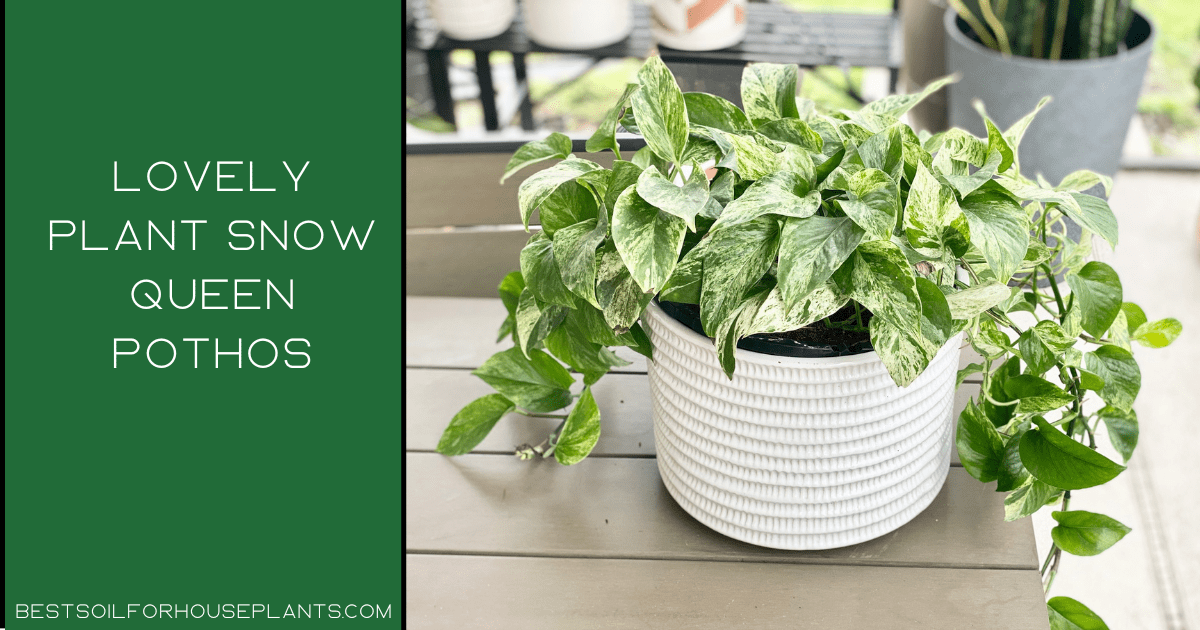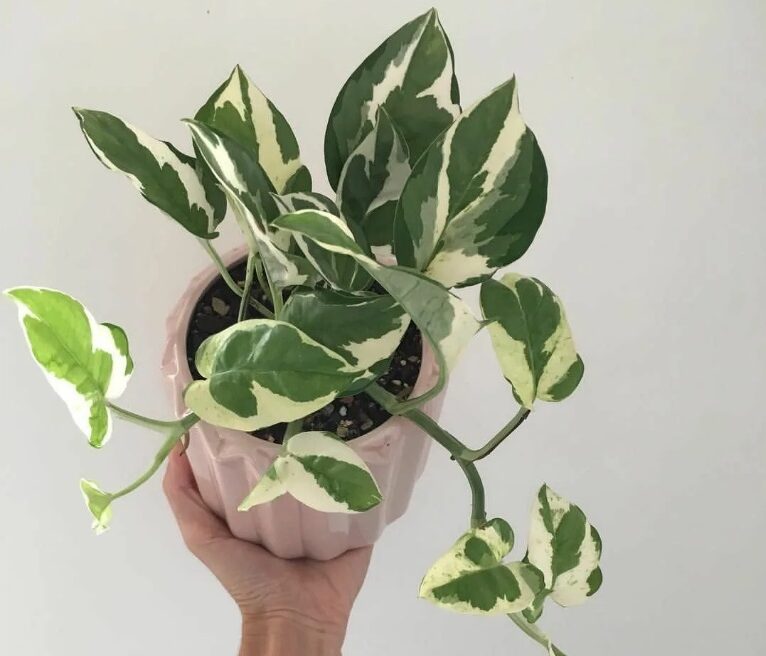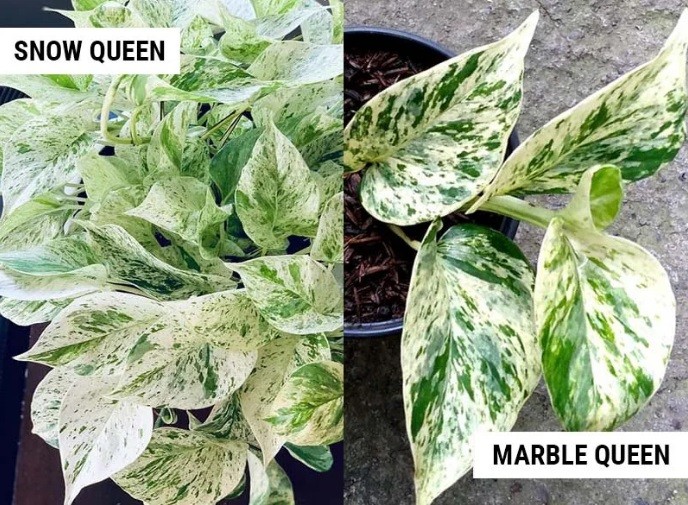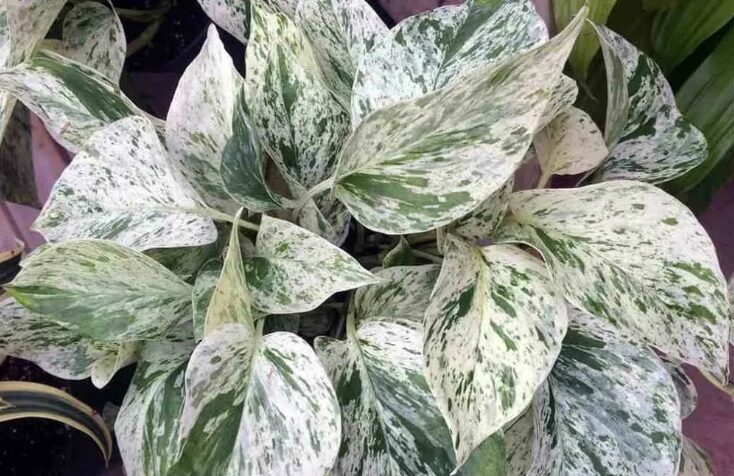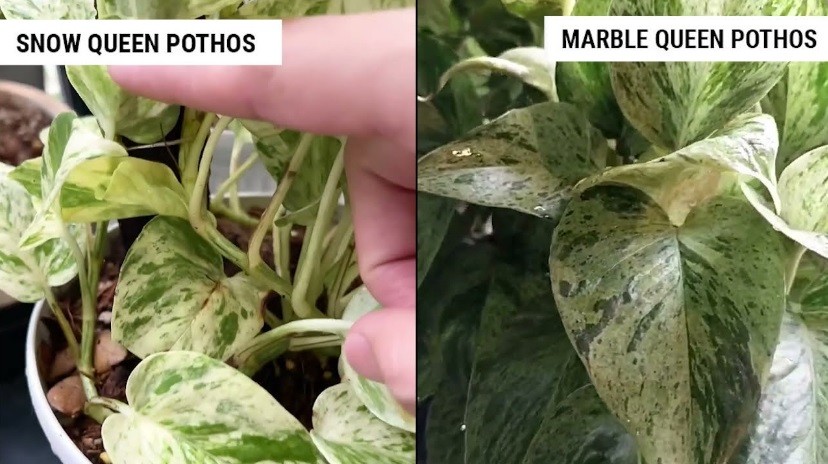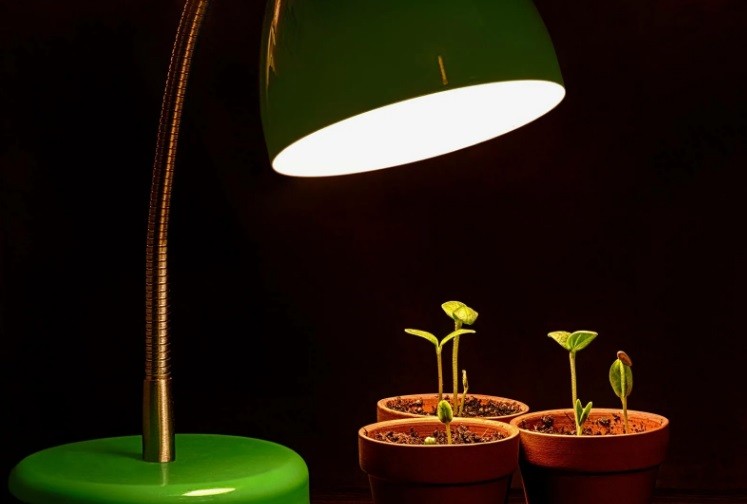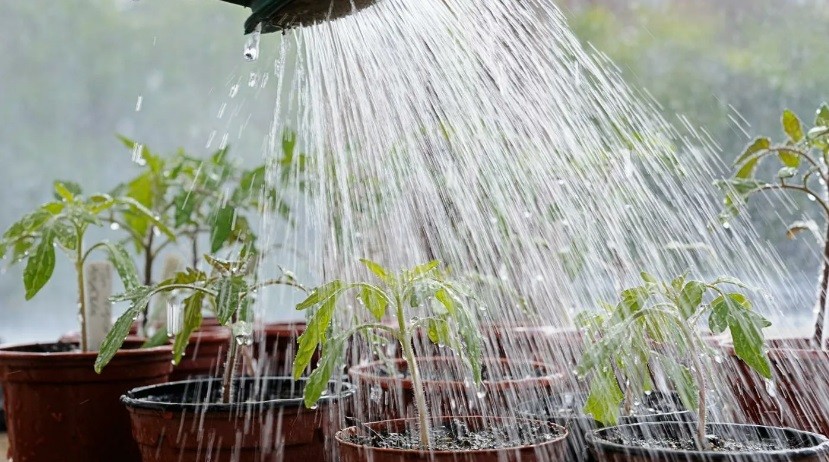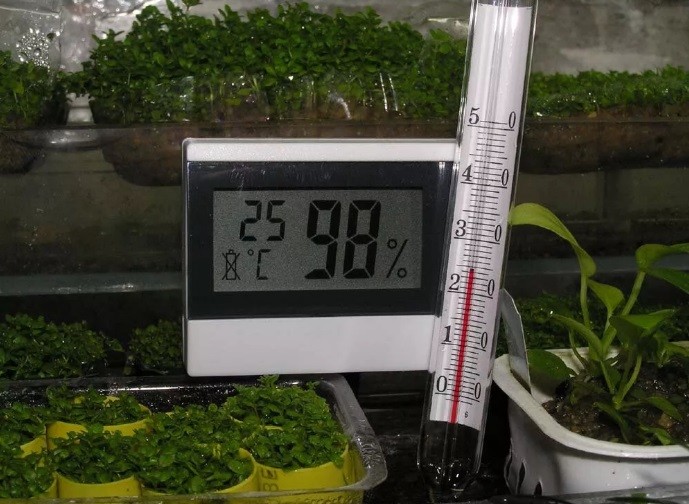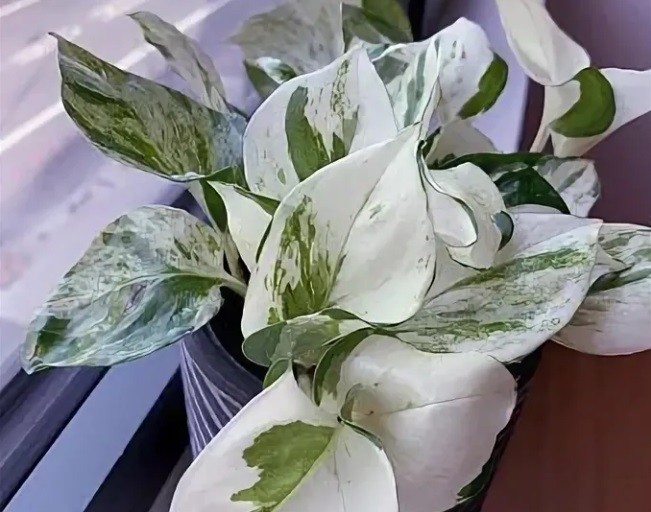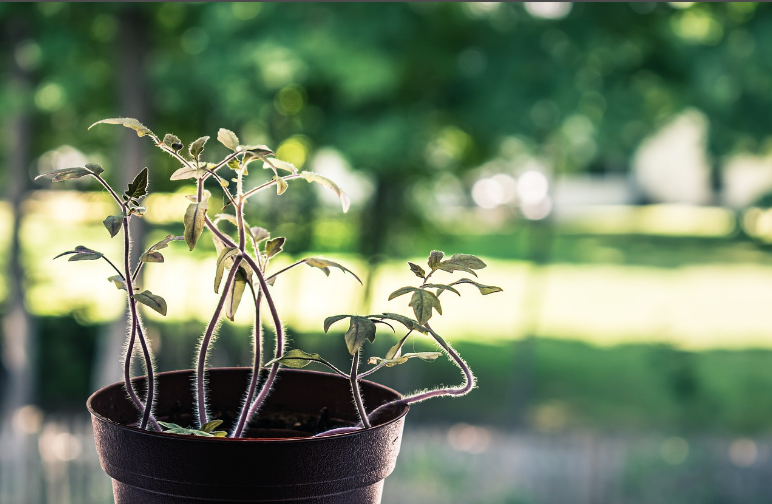Snow Queen pothos is a variety of epipremnum aureum. This houseplant has a big popularity among plant growers. So let’s learn something about this wonderful inexpensive plant!
This evergreen houseplant has heart-shaped green leathery leaves with white spots. It’s an extra large plant (can grow 1 meter and more) with long vines. It is very efficient in purifying the air of chemicals (xylene, formaldehyde, benzene). The Snow Queen pothos needs a very sufficient drainage holes for its health.
So if you are going to buy it, check the pot and small bugs hidden under the leaves! Then look, is it enough light for the plant. You can find information about the plant in the care tips below.
Snow Queen pothos origins
This plant is from Southeast Asia, pothos family plants. It is a hybrid, unique tropical plant because of its variegation. The leaves are very light with spots and speckles on them. The Marble Queen pothos plant is very similar to the Snow Queen pothos. So let’s have a look!
Is there a difference between Snow Queen pothos and Marble Queen pothos plants?
If you are a beginner gardener, you may get confused by these two types because they look similar. The best way to understand what type of plant you see is to look at the variegation and coloring on the leaves.
The Marble Queen pothos has green and yellow marbleized leaves. At least it has a speckled look. If a Marble Queen pothos is in lower light, the leaves will have more green color. The Snow Queen pothos is more white and less green. Marble Queen pothos grows faster than Snow Queen because it doesn’t have much chlorophyll, like Marble Queen pothos.
So if you don’t have extra space in your house, this plant can be a benefit for you!
They both have same plant parents and same genus. Their growing requirements are very similar to each other.
What are the similar diseases?
If you notice that something’s wrong with your plant, or it has pests, you should immediately isolate it from the other plants in your house to prevent spreading the infection. These plants both are susceptible to different houseplant pests (scale, spiders mites, aphids, mealybugs and etc.) or root rot (if you overwater them for a long time).
Is it toxic?
Unfortunately, yes. All pothos plants have oxalic acid, which is harmful for pets and also for a human. Keep away this plant off reach of your pets and small children.
Are Snow Queen pothos or Marble Queen pothos easy to care for?
I guess it has few needs, that’s why the plant is a great option to care not only for adults, but for kids. It doesn’t need direct sunlight and has low water needs. Let’s talk about Snow Queen pothos care.
Lighting requirements
Without enough indirect lighting, this plant will lose its white leaves. Because these white areas don’t contain chlorophyll, which helps the plant absorb energy from light to undergo photosynthesis. And they revert back to green.
Many others pothos plants don’t need so much light to grow well. Keep it away from direct sunlight to prevent unpleasant conditions. How much light does a Snow Queen pothos need? There should be a bright light around 4-6 hours a day.
Type of water
It is very important what type of water you prefer for your plants. The water must be without any chemicals, chlorine etc. That’s why don’t use domestic water. To avoid unpleasant consequences, use trapped rainwater or sterilized water.
It is bad for your plant if you overwater it. You should water it until the water pours out of the drainage holes. Please do it once in 3-4 weeks or find your own optimal way of the watering frequency. Always allow the soil to dry out fully, before giving water again and again!
Temperature and humidity
This beautiful plant is doing well in all household humidity levels with temperatures between 60-85 degrees Fahrenheit. And extra humidity with light and good temperatures keep the leaves white.
The best way to keep the optimal humidity for the Snow Queen pothos plants is to buy a humidifier. Also, you can mist plants’ leaves with a spray bottle once or twice a week or keep your plant in a bathroom!
Soil
Snow Queen pothos plant needs well-draining soil to prevent root rot (pH levels of around 6.0-6.5.) You can buy the soil in a garden store or make it on your own. But remember that soil should have vermiculite, peat, perlite.
Fertilizer
In fact, if you have a high-quality soil with nutrients in it, the pothos plants don’t need to be fertilized. You may apply a fertilizer with phosphorus, potassium, nitrogen once a month during the spring and summer season because this time the plant is actively growing. Please don’t do it during the fall or winter. The plant is in dormant mode.
Pruning
Pruning is not required, but it can help to control the size and shape of pothos plants. Pruning should be done in the spring or early summer when the pothos plant is actively growing.
First of all you need to use a pair of scissors. You cut off yellow leaves and you may cut long vines to promote a bushy growth. Also pinch the ends of the plant’s stem. Then they can be rooted in water then planted into the pot with soil, so it gives you a bushy Snow Queen.
Propagation
Snow Queen plants are easy to propagate. As I previously said, you need a sharp pair of scissors. Be sure that there are 3-4 nodes on the cutting. Nodes are the bumps along the stem where leaves and roots grow.
Then cut off some leaves and 1-2 nodes. Put the cutting in the water. Be sure that leaves are above it and don’t receive direct sunlight. Refresh water every week. Be sure all growth points are under the water.
When your roots begin to grow, you can move your cutting from water to soil with bright, indirect light. You should remember that roots need to acclimate. That’s why you have to water them from time to time. It takes a month to develop in soil.
Snow Queen pothos problems
Snow Queen pothos plants have some common problems. Here they are.
Temperature changes
The ideal temperature for Snow Queen pothos plant must be between 65-85 degrees Fahrenheit. Vent or air conditioner may cause a stress. Move your pathos plants away from the spot.
Too Much or Not Enough Sunlight
Pothos plants are very variegated plants. So if you notice that leaves are turning greener and white parts are fading away, it is a signal that Snow Queen pothos care is wrong. Leaves must receive enough sunlight.
Remember that these white areas on leaves don’t produce food for the plant, so your Snow Queen pothos should make the most of the available green parts of the leaves.
You should find another high light spots in your house that can give your plant a bit more sunlight if this is the case. The variegation of your Snow Queen pothos should return within one week or two.
When leaves become yellow, it is a signal that they receive excessive amount of sunlight. You must find another spot to place your plant in your house. Just try and find the best one!
Over-Fertilizing
Snow Queen pothos doesn’t need a lot of feeding. Actually, it is very dangerous when your plant is over-fertilized by nutrients.
If you notice your indoor plants’ leaves start curling or turning yellow, that means you are feeding them too much.
Simply read the manufacturer’s instructions for the proper use of the fertilizer. Don’t forget about the proper Snow Queen pothos care. Maybe you need to dilute the fertilizer to half to keep your plant healthy.
If you have already applied too much fertilizer, then flush the fertilizer with water mixture. And stop applying fertilizer for some time until your plant recovers.
Overwatering or Under-Watering
Snow Queen pothos doesn’t need excess water to be a happy plant.
The soil of the Snow Queen pothos prefer not to be boggy, so do not give your pothos plant a drink constantly. And the important thing is that the small pot or big pot must have some drain holes.
Check the soil moist of pothos plant frequently. And you will understand how often you should water the soil.
If you see the Snow Queen leaves become yellow, so this is an indication of overwatering. Brown leaves mean that you don’t give the plant enough water. It is not a proper care.
Brown and yellow leaves
Brown and crispy leaves are a sign that snow queen pothos care is not correct and the plant in need of moisture. It depends on the lack of humidity or underwatering. So to prevent further damage to the leaves, stop underwater them because underwatering plants causes dry and brown leaves.
There are some different reasons why your plant has yellow leaves. Of course, old leaves naturally become yellow. It is normal. But if there are a lot of new leaves turn yellow, it is a bad result of Snow Queen pothos care (root rot, underwatering, lack of sunlight).
Curling leaves
If your plant has curling leaves, it is a sign the pothos is underwatered.
Losing variegation
It is always a result of a lack of light. Your plant should receive bright indirect light to keep its white variegation healthy.
The conclusion
This article gives you the understanding of Snow Queen pothos care. The Snow Queen is a really simple and unique indoor plant which everybody can easily have. It has minimal care needs and minimal problems. If the problems appear, they can be easily solved.
All pothos varieties are cultivars of the epipremnum aureum, commonly known as pothos. Don’t forget that the Snow Queen pothos is different from the golden pothos. They are developed through selective breeding. If you are interested in this pothos because of its beautiful look, simple care, simple pruning routine, go and buy it! It is so easy to keep it look healthy without any problems. It is a great addition to your home.
This plant in your home will attract the attention of any guest. Because it is very pleasing to the eye. You can place it wherever you want! It is not a hardy plant.
These plants are easy to grow for the beginner gardeners and for children too.
Read also: Begonia Corallina – a wonderful guide for care, possible problems and the solutions in 2022
Orange star houseplant care: useful tips and secrets, photos of plants
Can Snow Queen pothos grow in water?
Yes, Snow Queen pothos can be grown in water. However, it is important to note that the plant will eventually need to be transplanted into soil as it cannot survive solely in water. Additionally, it is also important to ensure that the water is kept clean and changed regularly to prevent the growth of harmful bacteria.
Why is my snow Queen dying?
It is difficult to determine the exact reason why your snow Queen is dying without more information about the plant’s growing conditions and the symptoms it is experiencing. Some common causes of plant death include pests, disease, lack of water, too much or too little sunlight, and poor soil quality. It is also possible that the plant was not well-suited for the climate or environment in which it was planted. I suggest consulting with a professional or doing further research to determine the cause of the plant’s decline.
How do you make a snow queen bushy?
To make a snow queen bushy, you can add branches or foliage to the base of the snow queen sculpture. You can also add artificial or real snow around the base of the sculpture to create a more “bushy” appearance. Additionally, you can add other winter-themed decorations such as pinecones, holly berries, or mistletoe to give the sculpture a more natural, bushy look.
Why is my snow Queen pothos turning white?
It’s likely that your Snow Queen Pothos is getting too much direct sunlight, which can cause the leaves to turn white. Pothos plants prefer bright, indirect light and can scorch in direct sunlight. Make sure to place it in a location where it gets bright, indirect light, and monitor the plant for further changes. Additionally, it could be due to a pest infestation or a nutrient deficiency. If the problem persists, consider consulting with a local nursery or gardening expert for further advice.

